Scuba diving locations offer a breathtaking glimpse into the hidden depths of our oceans, promising an unforgettable experience for adventurers of all levels. From vibrant coral reefs teeming with marine life to enigmatic wrecks and mysterious caves, the underwater world beckons with its allure.
As you delve into the depths, you’ll encounter a symphony of colors, shapes, and textures, leaving you in awe of the planet’s natural beauty. Scuba diving locations provide a sanctuary for marine creatures, allowing you to witness their fascinating behaviors and interactions.
Popular Scuba Diving Locations
When selecting a scuba diving destination, several factors contribute to its popularity. These include visibility, marine life diversity and abundance, accessibility, and the availability of dive sites catering to various skill levels.
When it comes to selecting the ideal scuba diving destinations, there are numerous factors to consider. Whether you’re a seasoned diver or just starting out, finding the perfect location that aligns with your skill level and interests is crucial. Explore a comprehensive guide to scuba diving locations worldwide, providing valuable insights into the best spots for unforgettable underwater adventures.
Here’s a list of the top 10 most popular scuba diving destinations worldwide:
Great Barrier Reef, Australia
- The largest coral reef system in the world, stretching over 1,400 miles.
- Home to an astonishing array of marine life, including over 1,500 species of fish and 400 types of coral.
- Excellent visibility and a wide range of dive sites for all levels of experience.
Cozumel, Mexico
- Known for its crystal-clear waters and dramatic underwater topography, including sheer walls, swim-throughs, and coral gardens.
- Abundant marine life, including stingrays, turtles, sharks, and a vast array of tropical fish.
- Easy access from the mainland and a variety of dive operators catering to all levels of divers.
Galapagos Islands, Ecuador
- A unique underwater ecosystem, famous for its encounters with marine iguanas, sea lions, and hammerhead sharks.
- Exceptional visibility and a wide variety of dive sites, from shallow coral reefs to deep-water pinnacles.
- Accessible by liveaboard or day trips from the mainland.
Types of Scuba Diving Locations
The underwater world offers a diverse range of environments, each with its unique characteristics and attractions for scuba divers. From vibrant coral reefs teeming with marine life to historic shipwrecks and enigmatic caves, there are countless types of scuba diving locations to explore.
There are numerous scuba diving locations around the world, each offering unique experiences and marine life. Whether you’re a seasoned diver or a beginner looking to explore the underwater world, there’s a scuba diving location perfect for you. From the vibrant coral reefs of the Caribbean to the deep blue waters of the Pacific, there are endless opportunities to discover the beauty and wonder of the ocean.
Coral Reefs
Coral reefs are underwater ecosystems composed of living colonies of corals. They provide a habitat for a vast array of marine organisms, including fish, invertebrates, and algae. Coral reefs are renowned for their colorful and diverse marine life, making them a popular destination for scuba divers.
Wrecks
Shipwrecks are the remains of sunken vessels that have become artificial reefs. They offer a glimpse into maritime history and provide a unique environment for marine life. Wrecks can range from small fishing boats to large warships, and each one has its own story to tell.
Exploring the depths of the ocean can be an unforgettable experience, especially for families looking for an adventurous vacation. Scuba diving locations offer a unique opportunity to witness the wonders of the underwater world. If you’re seeking a cost-effective way to create lasting memories, consider budget family vacations.
With careful planning, you can find scuba diving destinations that cater to all ages and budgets, ensuring an unforgettable family experience.
Caves
Underwater caves offer a challenging and rewarding experience for experienced divers. They require specialized equipment and training, but they can provide access to hidden chambers and pristine underwater environments. Cave diving requires careful planning and risk assessment, but it can be an unforgettable experience.
Choosing a Scuba Diving Location
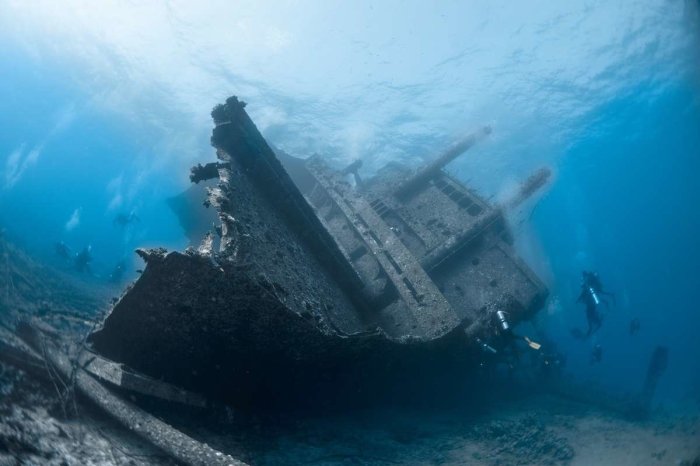
Selecting the ideal scuba diving destination depends on various factors, including your experience level, interests, and budget. Consider the following guidelines to make an informed decision:
Experience Level
For beginners, choosing locations with calm waters, good visibility, and easy-to-navigate dive sites is crucial. Some suitable options include the Caribbean Sea, the Great Barrier Reef, and the Maldives.
Intermediate divers may opt for destinations with more challenging dive sites, such as underwater caves or wrecks. Consider exploring the Red Sea, the Galapagos Islands, or the Cayman Islands.
Advanced divers can seek out locations with extreme depths, strong currents, or unique marine life. Destinations like the Blue Hole in Belize, the Great White Shark Cage Diving in South Africa, and the Sipadan Island in Malaysia cater to their adventurous spirit.
| Experience Level | Suitable Locations |
|---|---|
| Beginner | Caribbean Sea, Great Barrier Reef, Maldives |
| Intermediate | Red Sea, Galapagos Islands, Cayman Islands |
| Advanced | Blue Hole (Belize), Great White Shark Cage Diving (South Africa), Sipadan Island (Malaysia) |
Scuba Diving Safety Considerations
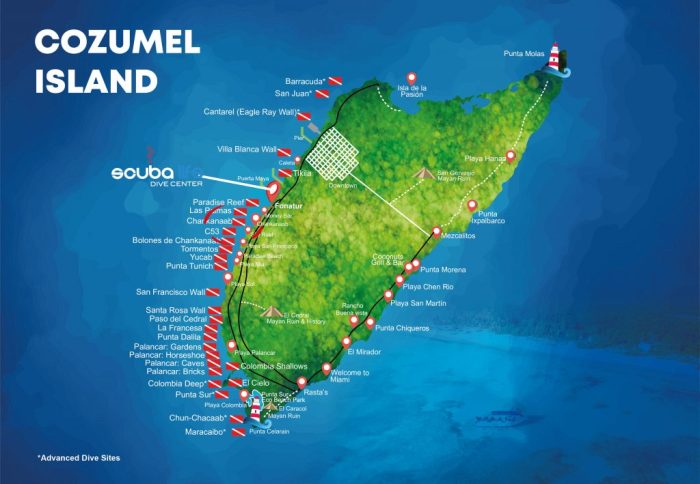
Scuba diving is an exhilarating and rewarding activity, but it’s essential to prioritize safety to ensure an enjoyable and incident-free experience. Divers should adhere to established guidelines and practices to mitigate risks and maximize their safety.
Here are some crucial safety tips for scuba divers:
Stay Within Your Limits, Scuba diving locations
- Divers should only dive within their skill level and experience. Overestimating abilities can lead to dangerous situations.
- Respect depth limits and avoid exceeding the maximum depth for which you are certified.
- Plan dives conservatively, considering factors such as depth, duration, and visibility.
Dive with a Buddy
- Always dive with a qualified buddy. Having a companion allows for assistance in emergencies and provides an extra set of eyes for safety.
- Stay in visual contact with your buddy throughout the dive.
- Establish clear hand signals and communication protocols.
Be Aware of Your Surroundings
- Pay attention to your surroundings and anticipate potential hazards.
- Be aware of currents, tides, and other environmental factors that can affect your dive.
- Avoid diving in areas with poor visibility or strong currents.
Scuba Diving Equipment
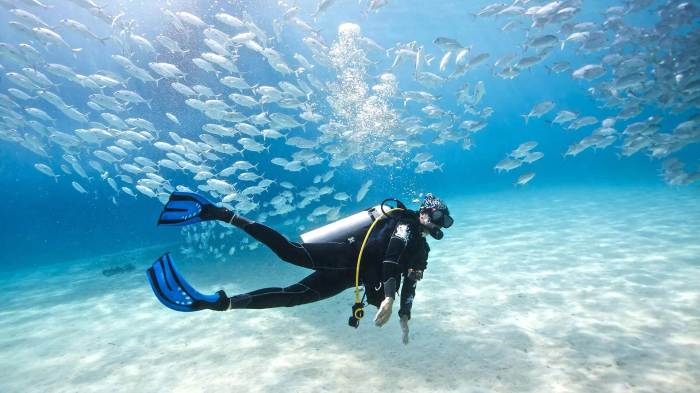
Scuba diving requires specialized equipment to ensure divers’ safety and comfort underwater. The essential gear includes a wetsuit, mask, fins, and regulator.
Wetsuit
A wetsuit is a full-body garment that provides insulation and protection from cold water. Divers should choose a wetsuit that fits snugly to minimize water flow and heat loss. The thickness of the wetsuit should be appropriate for the water temperature and diving conditions.
Mask
A mask provides clear vision underwater. It should fit comfortably around the diver’s face, creating a seal to prevent water from entering. Masks come in various shapes and sizes, so divers should try on different models to find the best fit.
Fins
Fins provide propulsion underwater. They come in different sizes and styles, each designed for specific diving conditions. Divers should choose fins that are appropriate for their experience level and the type of diving they plan to do.
Regulator
A regulator is a device that controls the flow of compressed air from the scuba tank to the diver’s mouthpiece. It ensures that the diver receives air at a breathable pressure. Regulators come in different configurations, so divers should consult with a dive professional to determine the best option for their needs.
Scuba Diving Training and Certification: Scuba Diving Locations
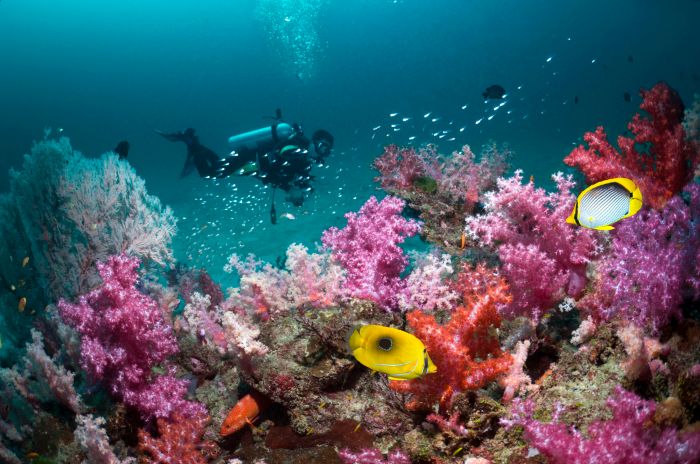
Scuba diving is a popular and rewarding activity, but it’s important to get the proper training and certification before you go diving. This will help you stay safe and enjoy your dives to the fullest.
There are different levels of scuba diving training and certification available, depending on your experience and interests. The most basic level is the Open Water Diver certification, which qualifies you to dive to a depth of 18 meters (60 feet). More advanced certifications, such as the Advanced Open Water Diver and Rescue Diver certifications, allow you to dive deeper and in more challenging conditions.
Getting certified is a relatively straightforward process. You’ll need to find a reputable scuba diving school and complete a course that includes both classroom and in-water training. Once you’ve completed the course, you’ll be issued a certification card that proves you’re qualified to dive.
It’s important to note that scuba diving is a potentially dangerous activity, and it’s important to be aware of the risks before you go diving. However, with the proper training and certification, you can safely enjoy the underwater world.
Importance of Getting Certified
There are many reasons why it’s important to get certified before scuba diving. First and foremost, it’s the law in many countries. In the United States, for example, it’s illegal to dive without a certification card.
Second, getting certified will help you stay safe. A certified diver has the knowledge and skills to handle emergencies and avoid accidents.
Third, getting certified will make your dives more enjoyable. A certified diver is more confident and comfortable underwater, which allows them to relax and enjoy the experience.
Process of Obtaining a Scuba Diving Certification
The process of obtaining a scuba diving certification is relatively straightforward. You’ll need to find a reputable scuba diving school and complete a course that includes both classroom and in-water training.
The classroom portion of the course will cover topics such as dive theory, equipment use, and safety procedures. The in-water portion of the course will give you the opportunity to practice your skills in a controlled environment.
Once you’ve completed the course, you’ll be issued a certification card that proves you’re qualified to dive. The certification card will typically include your name, date of birth, and the level of certification you’ve achieved.
Scuba Diving Travel Tips
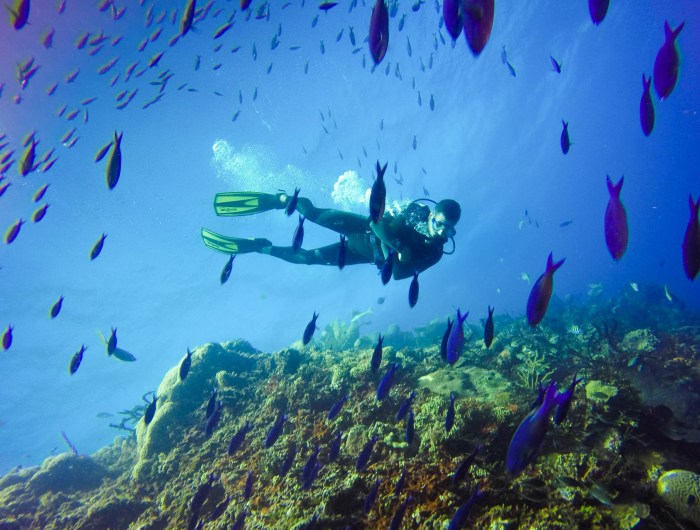
Planning a scuba diving trip requires careful preparation to ensure a safe and enjoyable experience. Here are some essential tips to consider:
Booking Accommodations
Choose accommodations that cater to scuba divers’ needs, such as those offering dive packages, gear storage, and easy access to dive sites. Consider factors like proximity to dive sites, amenities, and budget.
Finding a Dive Operator
Select a reputable dive operator with experienced staff, well-maintained equipment, and a proven safety record. Research online reviews, check certifications, and inquire about their dive procedures and safety protocols.
Packing for the Trip
Pack essential scuba diving gear, including a wetsuit or drysuit, mask, snorkel, fins, and buoyancy compensator device (BCD). Bring appropriate clothing for various weather conditions and comfortable footwear for walking on dive sites. Consider bringing a waterproof camera to capture underwater memories.
Travel Insurance
Travel insurance is crucial for scuba divers. It provides coverage for unexpected events, such as medical emergencies, lost luggage, trip cancellations, and dive-related accidents. Ensure the policy covers scuba diving activities and provides adequate coverage for your needs.
Last Word
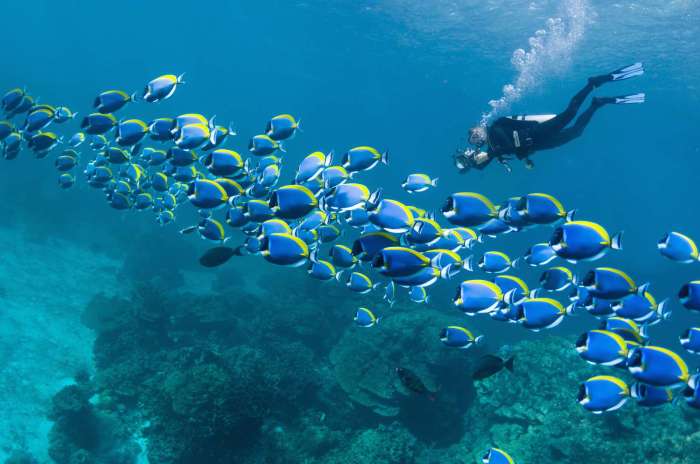
Whether you’re a seasoned diver or a novice yearning to explore the underwater realm, there’s a scuba diving location waiting to captivate you. Embrace the opportunity to immerse yourself in the wonders of the deep, creating memories that will last a lifetime.
Frequently Asked Questions
What are the factors that make a scuba diving location popular?
Visibility, abundance of marine life, accessibility, and unique underwater features.
What are some of the most popular scuba diving destinations worldwide?
Great Barrier Reef (Australia), Maldives, Red Sea (Egypt), Galapagos Islands (Ecuador), and Raja Ampat (Indonesia).
How do I choose the right scuba diving location for my experience level?
Consider your diving experience, interests, and budget. Research different locations and consult with dive operators to find one that suits your needs.